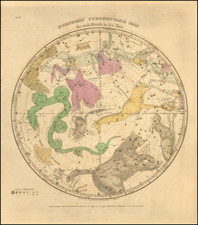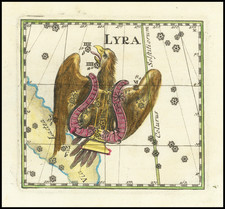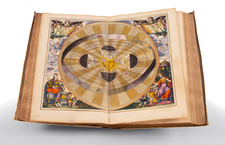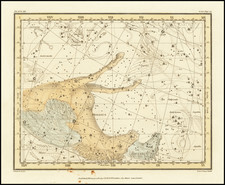Observing The Movement of the Planets
Doppelmayr's chart is a remarkable illustration of celestial phenomenae. Its primary emphasis lies in depicting the intricate orbits of Mars, Jupiter, and Saturn based upon Tycho Brahe's model, focusing particularly on the years 1712 and 1713.
Doppelmayr's chart intriguingly offers more than just a linear portrayal of planetary paths. It goes beyond to showcase the geocentric journey of the sun and planets around Earth, offering a panoramic view that emphasizes Earth's centrality. This geocentric model was pivotal during Brahe's time, challenging the Copernican model which proposed a heliocentric universe.
Adding depth of the subject, smaller hemispheres at the upper edges of the chart delineate the regressive movements of the planets. These regressions are complemented by lengthy explanations nestled in the two lower hemispheres, bringing forth a holistic understanding of the celestial movements. An elegant touch is the incorporation of cherubs, symbolic of the planets, dancing gracefully through the heavenly realms, adding an aesthetic and imaginative facet to the scientific representation.
Translating the text provided, it asserts:
We here present to the eyes of astronomical enthusiasts the periodic movements of the superior planets, just as they are composed according to Tycho's hypothesis from two elements (For every primary planet, besides its movement in its own orbit, enjoys also another simultaneous movement as this same orbit, along with the Sun, encircles annually through the zodiac, degenerating here into curves approaching spirals, to make more evident the superiority and simplicity of the Copernican system over Tycho's; in the former, primary planets always describe their nearest circular orbits by their single, simple and perpetually returning line, hence the superfluous multitude of movements and spirals is entirely removed. Moreover, it is wonderfully facilitated so that not only the center of the Earth, but also the centers and nodes of the primary planets are presumed to move over the same space and time annually). Finally, we also indicate here that according to Tycho's hypothesis, Mars, at certain times, lingers in that space of the world where the Sun otherwise existed, which is most contrary to astronomical elegance: from these words, it is easily gathered, it is much more believable that smaller bodies orbit a vast body like the Sun, than that it with the entire mechanism of things could orbit around."
Further, with the orbits' centers for the primary planets not far from the Sun's center or the common node, and the Sun according to Tycho completing its annual cycle, the orbits and centers of these planets are necessarily carried around. This continuous displacement of orbits means that planets define curved lines in the sky, which is better demonstrated here through Figure II. Thus, through these delineations, the motion of the planets, their orbit changes, and the curvatures they form in the sky are lucidly demonstrated, offering an insight into Brahe's interpretation of the celestial dance.
In conclusion, Johann Gabriele Doppelmayr's chart serves as an artistic and scientific merger, presenting Tycho Brahe's celestial model in its complex grandeur. It is an ode to a time when astronomy was transitioning, and models of the universe were in active debate, celebrating the confluence of art, science, and imagination.









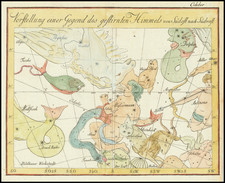
![Boussole des vents ou leurs noms tant Anciens que Modernes sont Diuisez en six Cercles suivant les principales Nations de l'Europe [Compass Rose & Wind Heads]](https://storage.googleapis.com/raremaps/img/small/84965.jpg)
